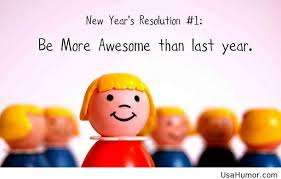 Like most Americans, I took a little time for myself at the end of 2014. I spent some of it celebrating the holidays with my family. I spent a little more of it celebrating the nuptials of an old friend. I spent the remainder of it in Napa Valley ringing in the new year over a few nice bottles of wine. While recharging my batteries, I came across a USA Today article from John Waggoner titled “Resolutions you can keep“. Maybe it is the wine talking, but I believe there are three important concepts in the final two column inches of this article that non-profit organizations should take to heart as they start a new year. I will focus on each of these three ideas in my next three blog posts. Today’s post focuses on sustainable giving strategies.
Like most Americans, I took a little time for myself at the end of 2014. I spent some of it celebrating the holidays with my family. I spent a little more of it celebrating the nuptials of an old friend. I spent the remainder of it in Napa Valley ringing in the new year over a few nice bottles of wine. While recharging my batteries, I came across a USA Today article from John Waggoner titled “Resolutions you can keep“. Maybe it is the wine talking, but I believe there are three important concepts in the final two column inches of this article that non-profit organizations should take to heart as they start a new year. I will focus on each of these three ideas in my next three blog posts. Today’s post focuses on sustainable giving strategies.
As I just mentioned, Waggoner dedicated the last two inches of his new year’s resolutions article to charitable giving. The following is some of his advice to readers:
“It’s easier to give to charity if you put some money aside each paycheck, just as you do for your own savings. You’ll get a tax deduction for your donation, of course, but they’s not the reason to give to charity. Government can help alleviate some of the world’s woes, but not all of them — and when you give to charity, you get to choose how your money is used.“
Three short sentences. Lots of wisdom!
 As a donor, I discovered long ago that if I want to make a large contribution to a non-profit organization it probably won’t happen by writing one large check. While some people on this planet have that capacity, my bank account balance isn’t fat enough to do something like Bill Gates or Warren Buffet. However, “large contribution” is a relative term, and I made my first meaningful, sacrificial gift at the age of 27 when I pledged $1,000 to a local Boy Scout council while earning $27,000 working for that same organization.
As a donor, I discovered long ago that if I want to make a large contribution to a non-profit organization it probably won’t happen by writing one large check. While some people on this planet have that capacity, my bank account balance isn’t fat enough to do something like Bill Gates or Warren Buffet. However, “large contribution” is a relative term, and I made my first meaningful, sacrificial gift at the age of 27 when I pledged $1,000 to a local Boy Scout council while earning $27,000 working for that same organization.
At first, giving away almost 4% of my gross salary seemed impossible and crazy, especially when looking at expenditures like student loans, rent for a suburban Chicago apartment, not to mention food and transportation. I wouldn’t have ever been to write a $1,000 check at that time in my life. However, when the person soliciting me for that gift helped me see that a $1,000 annual campaign contribution was merely $38.46 per paycheck, I was hooked!
As Waggoner said, putting a little money aside from each paycheck can add up and quickly become a very nice charitable gift.
Of course, the challenge for your non-profit is figuring out how to help your supporters and donors come to this conclusion without offending them.
One strategy that I don’t believe ever works is telling a donor what they can do without. For example, I once heard a fundraising volunteer suggest that forgoing one cup of Starbucks coffee once a week would be the equivalent of a $250 charitable gift.
My reaction? Bite your tongue!
Why in the world would you ever want to frame someone’s charitable giving as a choice between doing good and consuming something they obviously enjoy? (And if you do employ this strategy, then you better be 100% sure the donor values your mission a lot more than they value what you’re suggesting they give up.)
The following are three strategies I find more effective and suggest you look at integrating into your 2015 resource development plan.
Workplace campaign
 The United Way figured this one out a long time ago, didn’t they?
The United Way figured this one out a long time ago, didn’t they?
Get permission from a company to talk to their employees about your mission, and then present them with an opportunity to make a contribution to your organization by using payroll deduction. Genius!
This strategy speaks directly to the idea in Waggoner’s USA Today article when it comes to setting aside a little bit of money from each paycheck. It is made even easier through payroll deduction because that which you never see is difficult to miss, right?
It is important to note that non-profit organizations who receive funding from United Way are most likely prohibited from engaging in workplace giving. If you are a United Way agency, please check your funding agreement first before approaching local businesses about the possibility of establishing a workplace giving initiative.
Of course, a workplace giving campaign doesn’t have to look like what the United Way has pioneered throughout the years. The Boys & Girls Club of Fort Atkinson approached it from a different angle with their “Blue Jeans for Blue Doors campaign“.
If you are interested in learning more about workplace giving, then I suggest clicking here to check out what Grant Space (a service of the Foundation Center) has to say on the subject.
Monthly giving
 Since the Great Recession of 2008, many non-profit organizations have explored and developed monthly giving programs. This strategy has been very popular with European charities, and it is akin to the “set it and forget it” mentality of our society.
Since the Great Recession of 2008, many non-profit organizations have explored and developed monthly giving programs. This strategy has been very popular with European charities, and it is akin to the “set it and forget it” mentality of our society.
Like a workplace giving campaign, a monthly giving program allows your organization to re-frame the solicitation. So, rather than asking for $1,200, you ask them for a $100/month contribution. For many people, $100 per month feels a lot more realistic than a $1,200 annual gift.
One of my favorite monthly giving programs is Chicago Public Radio’s “High Fidelity” program. Your non-profit organization can learn a lot from benchmarking this program.
If benchmarking isn’t your cup of tea, then I suggest you read Joanne Fritz’s about.com article titled “Why Your Charity Should Have a Monthly Giving Program“. Afterward, you should look into signing up for Pamela Grow’s “Nonprofit Monthly Giving — The Basics & More” eCourse.
I’m an avid reader of Joanne’s work, and I’ve taken Pamela’s monthly giving eCourse. You won’t be disappointed!
Polish your annual campaign pledge drive
As I shared with you earlier in this post, I learned the value of sustainable giving when I made a pledge to my local Boy Scout council’s Friends of Scouting annual campaign pledge drive.
If you currently operate an annual campaign pledge drive as part of your resource development plan, I suggest the following:
- Look at your 2014 campaign data and determine what percentage of your donors made pledges versus outright gifts
- Review your campaign materials (e.g. internal case statement, pledge card, external case for support, etc) and look for verbiage about pledging
- Assess your internal systems (e.g. donor database, financial management software, accounts receivable procedures, etc) and determine if it is possible to add more monthly pledge reminders to the current workload
- Add a training section on how to emphasize the power of pledging to your annual campaign kickoff meeting
- Target your 2014 donors who made outright gifts with a specific solicitation message asking them to increase their gift by pledging/paying it over a longer period of time
Does your organization have other strategies on the planning table for 2015 when it comes to promoting sustainable giving? If so, please scroll down and share your thoughts and experiences in the comment box below. We can all learn from each other.
Here’s to your health!
Erik Anderson
Founder & President, The Healthy Non-Profit LLC
www.thehealthynonprofit.com
erik@thehealthynonprofit.com
http://twitter.com/#!/eanderson847
http://www.facebook.com/eanderson847
http://www.linkedin.com/in/erikanderson847
